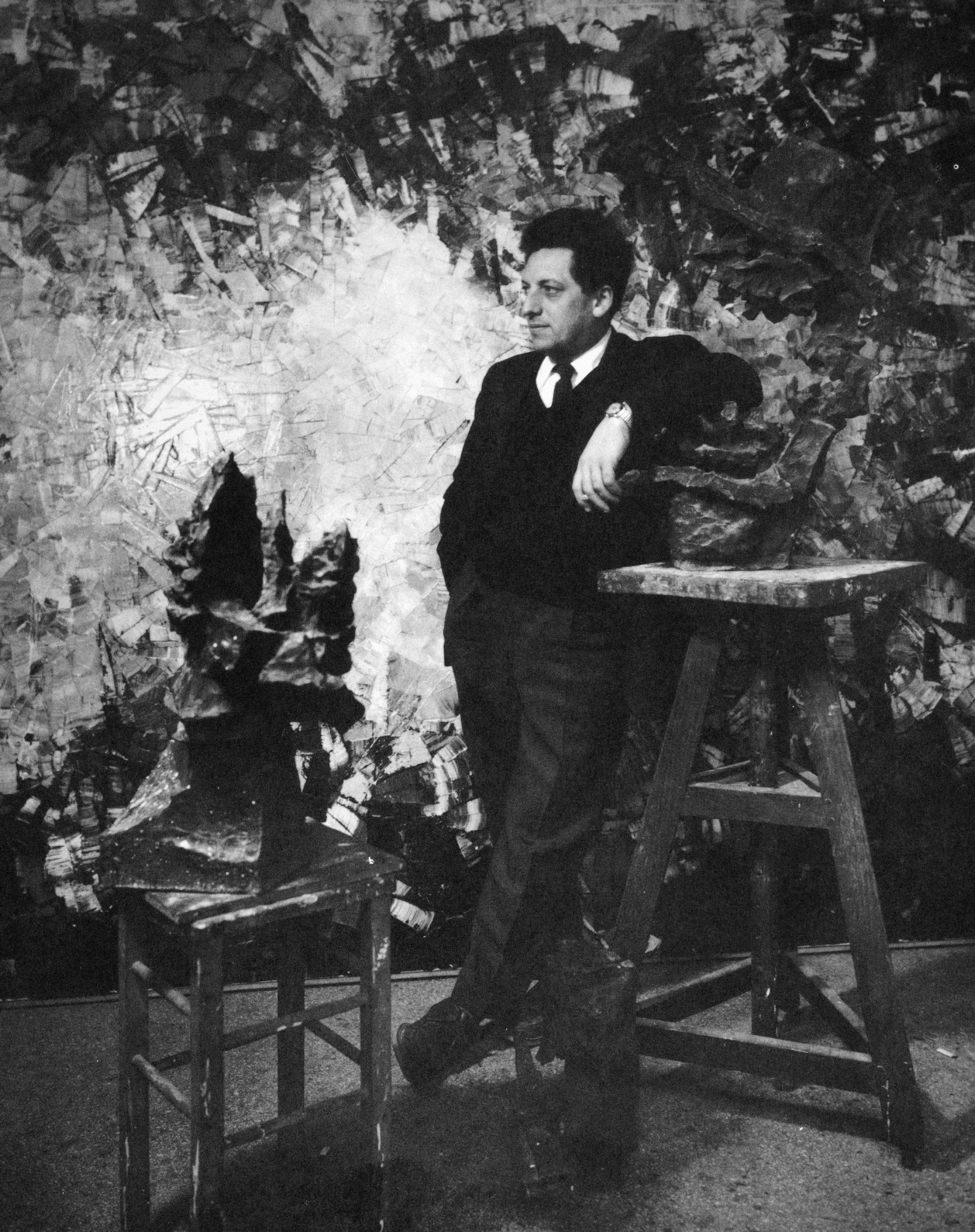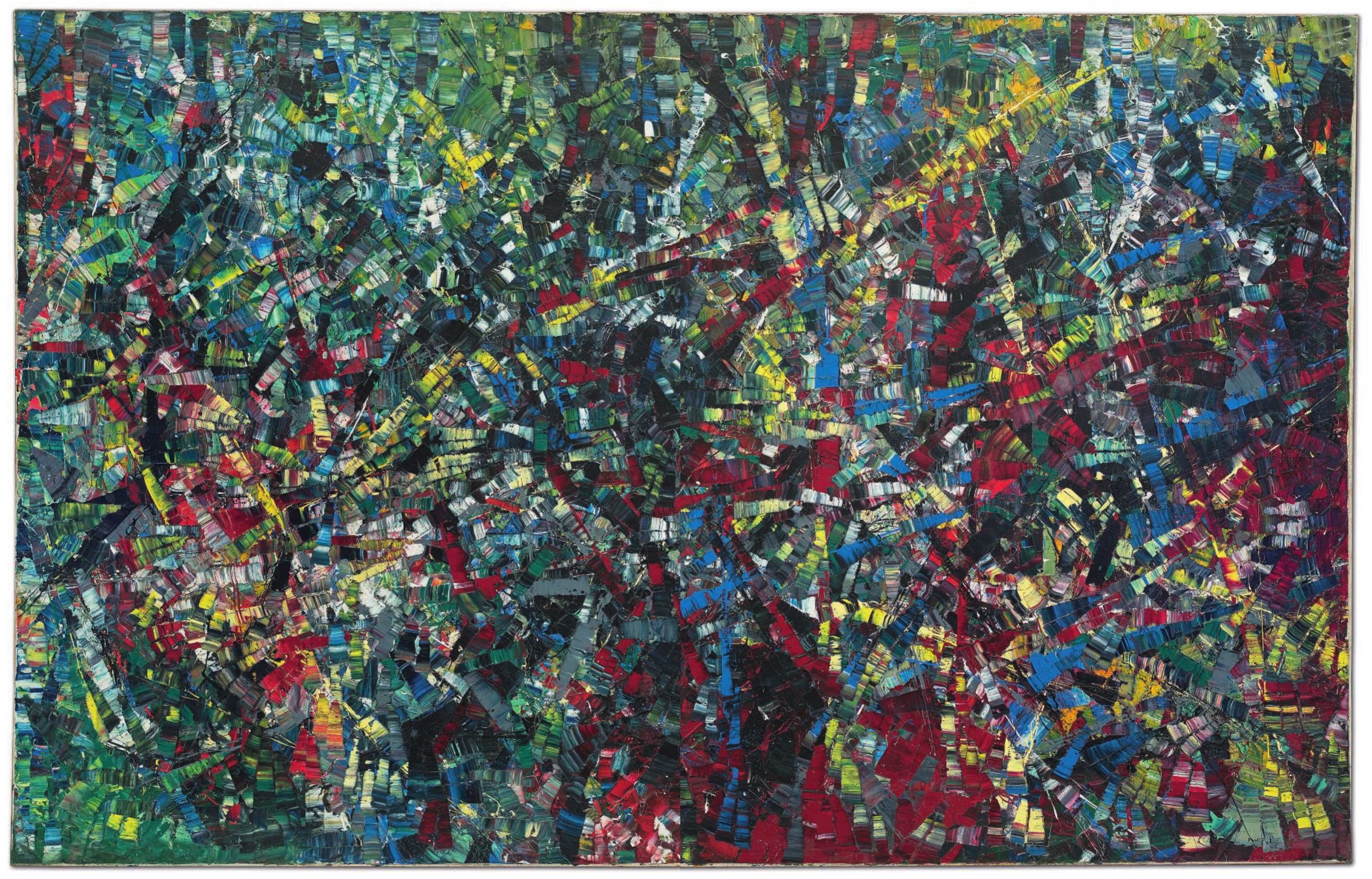Jean-Paul Riopelle (1923-2002): Focus
[2023年01月27日]

Jean-Paul Riopelle, photographed by Jacques Dubourg, c.1960.
Jean-Paul Riopelle would have been 100 years old today. A citizen of Quebec, Riopelle was a painter, sculptor and printmaker and is Canada’s most important and famous 20th century artist. His career spanned more than 60 years and his work has been the subject of many major exhibitions. Today, the value of his works reflects a global and long-standing recognition and his market remains as attractive as ever.
“My paintings are easy to recognize. They look like bed sheets that a house painter has used to wipe his brushes.” Jean-Paul Riopelle.
His life and his work
Born in Montreal in 1923, Jean-Paul RIOPELLE began drawing at a very early age. During his studies he met painter Paul-Émile Borduas, one of the founding members of the group of artists known as Les Automatistes. Borduas became his teacher and Riopelle made his first abstract works under his guidance. The movement was largely inspired by Surrealism and Abstract Expressionism with the difference that its protagonists sought total creative spontaneity including allowing their subconscious to influence their creative processes. In the early 1950s, Riopelle moved to Paris and mingled with Surrealists André Breton, Max Ernst and Samuel Beckett. He quickly became known in Paris and had his first solo exhibition at the Galerie du Dragon. This was followed by exhibitions in prestigious galleries in France and in New York.
Riopelle played a role in the artistic movement known as Lyrical Abstraction via his “mosaics” with color applied thickly to the canvas using a spatula and a palette knife. His paintings had neither center nor composition, neither beginning nor end and the chromatic structure tended to go beyond the limits of the painting. Similar to Monet’s later Water Lilies where the object almost disappears behind veils of color, Riopelle’s abstractions were like chromatic landscapes that seemed to evoke figurative memories.
“I don’t seek to abstract but rather to direct myself towards abstraction by liberating my gestures (I am not talking about ‘automatism’) in order to try to understand what nature is, not by basing myself on its destruction, but by getting closer to the world” Jean-Paul Riopelle
His style evolved enormously in 10 years. He experimented with a wide variety of techniques, from watercolor to oil, trying his hand at collage, lithography, Indian ink and even sculpture. The 1960s saw a return to figuration and, with the support of Aimé Maeght, Riopelle contributed to the development of modern printmaking.
Riopelle was also supported by the New York dealer, Pierre Matisse, and became friends with the American painters Sam Francis and Joan MITCHELL, the latter becoming his partner for nearly 25 years. Mitchell and Riopelle’s relationship was a mutual source of inspiration in their respective œuvres, even beyond their separation in 1979.
In 1962, Riopelle won the UNESCO prize at the Venice Biennale and his work began to be exhibited in major retrospectives around the world. In 1981, he received the Paul-Émile-Borduas prize for his œuvre as a whole. In 2000, the Musée du Québec inaugurated a permanent room dedicated to his work. During his last years, he lived in Quebec and died in the spring of 2002 at the age of 78 in his house on Île-aux-Grues, on the Saint-Laurent, where he had chosen to retire in the early 1990s.
An attractive market
“Jean-Paul Riopelle was a prolific artist and his works are scattered across the planet, which in itself is further testimony to his notoriety, the excellence of his work and its immense value… His large format canvases, the most sought-after, can be found in the most prestigious collections, but the majority of his production is in private hands. Over the coming years, we may well see a resurgence of his best and most famous works on the market.” Director of the Musée du Québec, John Porter during an interview in 2002
During his lifetime, Jean-Paul Riopelle produced nearly 7,000 works which are now scattered around the globe. Over the past 20 years, 2,000 have sold for auction prices usually varying between $10,000 and $500,000. But his best paintings from his sought-after “mosaic” period easily exceed a million dollars at auction, and his largest works can reach beyond 5 million.
In 1989, when the art market was experiencing one of its most prosperous periods, his painting Composition (1954) became the first Canadian artwork to cross the $1 million threshold at auction. In 2021 Christie’s in Paris sold his La sombreuse (1954) from a private collection for $4.2 million at its auction debut. Distinguished by its size and its strength, it is a symphony of dazzling colors applied using a highly controlled technique and is considered a key work in Riopelle’s career.

Jean-Paul Riopelle, la Sombreuse, 1954
Riopelle’s work first crossed the $1 million auction threshold in 2006, and in 2017 an Sans titre canvas painted in 1953 set his current auction record at $5.8 million. Painted when he was at the peak of his career, the work is a highly luminous combining spatula application with drippings in a festival of color. The canvas has all the characteristics of the artist’s most sought-after works. Last November, his Autriche III (1954) fetched $5.4 million at Christie’s in Hong Kong, his 3rd best-ever auction result.

Jean-Paul Riopelle, Sans Titre, 1953
In 2022, approximately 40 Riopelle works sold at auction for prices ranging from $50,000 for the smallest to over $2 million for the largest. His most emblematic works were created in the period 1953-1954, and these works usually fetch his best prices.
Jean-Paul Riopelle occupies a unique place in the history of modern Canadian painters, and his work is both a liquid and a solid investment for collectors around the world.
In 2022, an active and relatively dense market gave Riopelle 111th place in our global ranking of artists with an annual auction turnover of $15.8 million.
What about the Canadian market?
As we can see in the two auction turnover rankings of Canadian artists below, their relative positions have evolved little over the last decade. They essentially revolve around four signatures.
| Top 10 canadian artists at auction in 2022 | |||
| ©Artprice.com |
| Artist | Turnover | Lots sold | Lots unsold | Record | |
| 1 | Philip GUSTON (1913-1980) | $41,929,512 | 40 | 3 | $18,000,000 |
| 2 | Agnes MARTIN (1912-2004) | $31,416,279 | 53 | 17 | $9,861,200 |
| 3 | Matthew WONG (1984-2019) | $21,351,921 | 15 | 5 | $5,897,150 |
| 4 | Jean-Paul RIOPELLE (1923-2002) | $19,525,730 | 262 | 102 | $5,437,590 |
| 5 | Anna WEYANT (1995) | $9,687,473 | 19 | 0 | $1,623,000 |
| 6 | Tom THOMSON (1877-1917) | $5,190,014 | 14 | 0 | $1,654,154 |
| 7 | Marcelle FERRON (1924-2001) | $2,848,082 | 41 | 5 | $1,350,409 |
| 8 | Alexander Young JACKSON (1882-1974) | $2,234,689 | 54 | 1 | $697,427 |
| 9 | John Hamilton BUSH (1909-1977) | $1,953,311 | 33 | 2 | $570,034 |
| 10 | Maud LEWIS (1903-1970) | $1,836,292 | 73 | 0 | $73,146 |
| Top 10 canadian artists at auction (2013-2022) | |||
| ©Artprice.com |
| Artist | Turnover | Lots sold | Lots unsold |
Record | |
| 1 | Philip GUSTON (1913-1980) | $235,039,275 | 278 | 59 | $25,883,750 |
| 2 | Agnes MARTIN (1912-2004) | $204,992,674 | 308 | 63 | $17,728,800 |
| 3 | Jean-Paul RIOPELLE (1923-2002) | $132,573,775 | 1215 | 407 | $5,772,677 |
| 4 | Matthew WONG (1984-2019) | $92,937,162 | 71 | 5 | $5,897,150 |
| 5 | John Hamilton BUSH (1909-1977) | $19,196,710 | 247 | 31 | $675,964 |
| 6 | Alexander Young JACKSON (1882-1974) | $17,885,961 | 577 | 59 | $697,427 |
| 7 | Tom THOMSON (1877-1917) | $12,586,777 | 48 | 4 | $1,654,154 |
| 8 | Richard HAMBLETON (1952-2017) | $12,271,734 | 221 | 52 | $552,772 |
| 9 | Jean-Paul LEMIEUX (1904-1990) | $11,786,927 | 302 | 69 | $1,270,704 |
| 10 | Anna WEYANT (1995) | $9,752,993 | 21 | 0 | $2,802,442 |
Among the top three most expensive works by Canadian artists sold during the past 10 years are:
In first place, “To Fellini” by Philip Guston (1913-1980), which fetched $25.9 million in 2013 at Christie’s New York, the artist’s best-ever auction result.
In second place, Agnès Martin’s Untitled #44 fetched $17.7million in May 2021 at Sotheby’s New York.
Then, somewhat further down the price ladder:
In third place, Matthew Wong’s « The Night Watcher » sold for $5.9 million at Sotheby’s New York and, in fourth place, Riopelle’s Sans titre (1953) fetched $5.7 million at Christie’s in Paris).
While the major international auction houses usually handle Riopelle’s most expensive works, Canadian auctioneers like Heffel Fine Art Auction and Cowley Abbott Fine Art (which recently sold one of the largest Canadian private collections frequently handle works by the major signatures in their country’s art history.




 30.6
30.6
